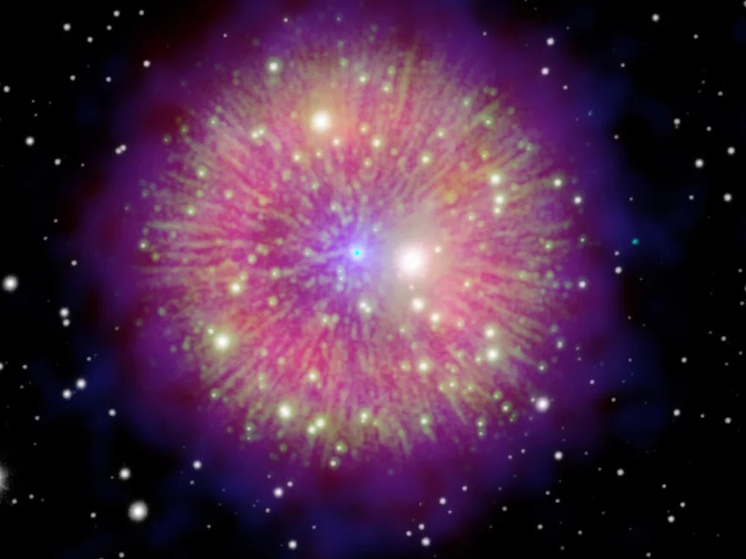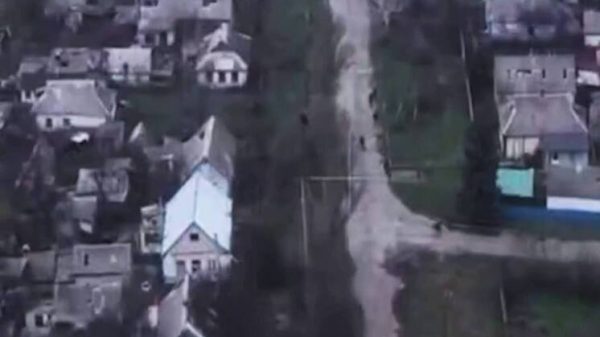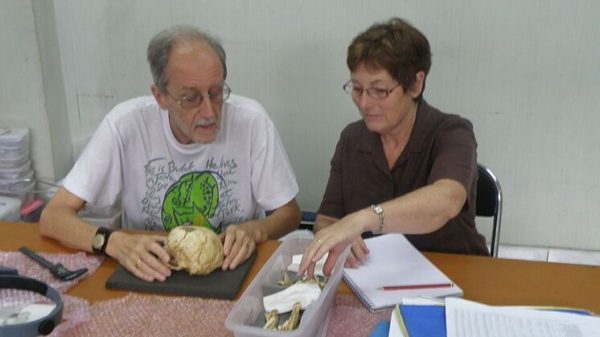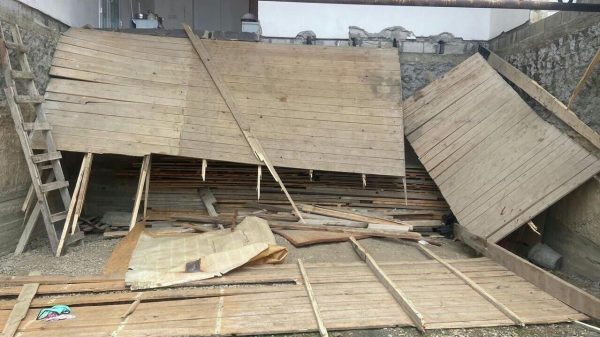The mystery that has puzzled astronomers for centuries has been solved
A thousand years ago, a supernova exploded in the night sky. Now, astronomers have discovered the remains of a «zombie star.» For six months in 1181, the dying star left its mark on the night sky. The striking object, bright as Saturn, appeared near the constellation Cassiopeia, and historical chronicles in China and Japan recorded it as a «guest star.» Chinese astronomers used the term to refer to a temporary object in the sky, often a comet or, as in this case, a supernova — a catastrophic explosion of a star at the end of its life.

The object, now known as SN 1181, is one of the few supernovae recorded before the invention of telescopes, and has puzzled astronomers for centuries, CNN reports.
Now, a new study has detailed SN 1181 for the first time, creating a computer model of the supernova's evolution from its first outburst to the present day. The research team compared the model with archival telescope observations of the nebula, a giant cloud of gas and dust visible to this day that is the remnant of a monumental event.
The researchers said their analysis strongly suggests that SN 1181 belongs to a rare class of supernovae called type Iax, in which the thermonuclear explosion can be the result of not one but two white dwarfs colliding but not fully exploding, leaving behind a «zombie star.» «There are 20 or 30 type Iax supernova candidates,» said Takatoshi Ko, lead author of the study published in The Astrophysical Journal. «But this is the only one we know of in our own galaxy.»What's more, the study also found that, inexplicably, the high-speed stellar wind detected in previous studies began blowing from the surface of the zombie star just 20 years ago, adding to the mysterious aura of SN 1181. Experts say uncovering the mechanism behind this supernova event could help astronomers better understand the life and death of stars and how they contribute to planet formation.
It took 840 years for astronomers to solve SN 1181's first great mystery — pinpointing its exact location in the Milky Way, CNN reports. The dying star was the last supernova to occur before the advent of the telescope, with no confirmed remnants until Albert Zijlstra, a professor of astrophysics at the University of Manchester in England, discovered it in a nebula in the constellation Cassiopeia in 2021.
Amateur astronomer Dana Patchick discovered the nebula in 2013 while combing through the archives of NASA's Wide-field Infrared Survey Explorer (WISE) telescope. But Zijlstra, who was not involved in the new study, was the first to make a connection with SN 1181.
“I had a quiet day at home during the height of Covid,” recalls Albert Zijlstra. “I matched the supernova to the nebula using records from ancient Chinese catalogues. I think it’s now widely accepted — a lot of people have looked at it and agreed that it’s probably right. It’s a remnant of that supernova.”
The nebula is about 7,000 light-years from Earth, and at its center is a rapidly spinning Earth-sized object called a white dwarf — a dense, dead star that has run out of nuclear fuel. This feature is unusual for a supernova remnant, since the explosion should have destroyed the white dwarf.
Zijlstra and his co-authors published a study about the discovery in September 2021. The report suggested that SN 1181 may belong to the elusive Type Iax supernova category due to the presence of this “zombie” white dwarf.
In the more common Type Ia supernova, a white dwarf, which forms when a Sun-like star runs out of fuel, begins accumulating material from another nearby star. Unlike the Sun, many stars exist in pairs or binary systems. The white dwarf accumulates material until it collapses under its own gravity, restarting nuclear fusion in a powerful explosion that creates one of the brightest objects in the universe.
A rarer type Iax is a scenario in which the explosion somehow stops. “One possibility is that type Iax is not so much an explosion as it is a merger of two white dwarfs,” Zijlstra said. “They come together, smashing into each other at full speed, and that can release a lot of energy. That energy causes a sudden supernova explosion.”
This massive collision could explain another curious aspect of the zombie star SN 1181. It contains no hydrogen or helium, which is highly unusual in the cosmos, Zijlstra said.
“About 90% of the universe is hydrogen, and the rest is almost exclusively helium. Anything else is pretty rare,” he said. “You have to look through 10,000 atoms before you find one that isn’t hydrogen or helium. But our star (the sun at the center of our solar system) has basically just those. So clearly something extraordinary has happened to the zombie star.”
Armed with information about where to look for SN 1181 and a hunch that it might be the remains of an Iax-type star, Ko and his colleagues set to work to unlock its remaining secrets.
“By precisely tracking the time evolution of the remnant, we were able to obtain detailed properties of the SN 1181 explosion for the first time. We confirmed that these detailed properties are consistent with a Type Iax supernova,” Ko said, adding that the computer model in the study is consistent with previous observations of the remnant using telescopes including the European Space Agency’s XMM-Newton space telescope and NASA’s Chandra X-ray Observatory.
Ko’s analysis shows that the SN 1181 remnant is made up of two distinct shock regions. The outer region formed when material ejected from the supernova explosion fell into interstellar space. The inner region, which formed more recently, is more difficult to explain.
The study suggests that this inner shock region could be a sign that the star has started burning again centuries after the explosion, leading to a surprising discovery, Ko added: The high-speed stellar wind appears to have started blowing from the star's surface just 20 to 30 years ago.
Typically, this fast-moving stream of particles, which astronomers call a stellar wind, should come from the white dwarf as a byproduct of the star's rapid rotation immediately after the supernova explosion.
“We don’t fully understand why the star flared up again and why the stellar wind started so recently,” Ko said. “We speculate that the star flared up again because SN 1181 was a Type Iax supernova, which is an incomplete explosion. As a result, the material ejected by the explosion was not completely blown away and remained within the gravitational influence of the central white dwarf. This material could eventually settle on the white dwarf under its gravity, causing it to flare up again.”
However, as Zijlstra noted, this theory contradicts observations that show the star has been dimming over the past century.
“It’s not clear how this is related to the increased wind,” he said. “I would expect the star to brighten, not dim.”
Ko and his colleagues are aware of the problem. They said they think there is some connection between the wind and the dimming, and they are studying it.
The researchers are preparing to make further observations of SN 1181 with two instruments they have not yet used: the Very Large Array of radio telescopes in New Mexico and the Subaru Telescope in Hawaii.
The research, Ko said, will help advance scientists' understanding of all supernovae.
«Type Ia supernovae played a critical role in discovering the accelerating expansion of the universe,» he said. «But despite their importance, their explosion mechanism remains unknown, making it one of the most challenging problems in modern astronomy.»
By studying SN 1181 and its incomplete explosion, he added, scientists can gain insight into the formation mechanism of Type Ia supernovae.
Because objects like SN 1181 are important in creating many of the elements that make up humans, studying them is a great opportunity, Zijlstra said.
“These very energetic events can produce elements heavier than iron, such as rare earth elements,” he said. “It’s very valuable to have an example of such an event from 1,000 years ago, where we can still see the materials that were ejected, and perhaps in the future we’ll be able to pinpoint exactly what elements were created in that event.”
This knowledge would help scientists understand how Earth formed and got its elements, Zijlstra added.
Historically, ancient supernova observations have been of paramount importance to modern astrophysics, said Bradley Schaefer, a professor emeritus of astrophysics and astronomy at Louisiana State University who was not involved in the latest study.
Schaefer added that SN 1181 represents one of the few reliable links between a supernova and a supernova remnant. The object is important because it is the only possible case of good observations of the elusive type Iax.
“Type Iax supernovae turn out to account for about 20 percent of all supernovae in any galaxy, including our Milky Way, and they may account for much of the mysterious dust in the early universe,” Schaefer said. In our lifetime, he added, astrophysicists will not get a better observational case for a Type Iax event, so researchers should make every effort to understand SN 1181.






















































Свежие комментарии